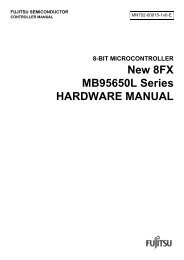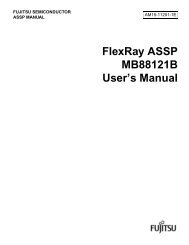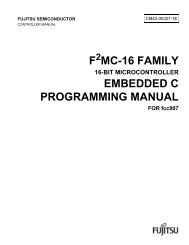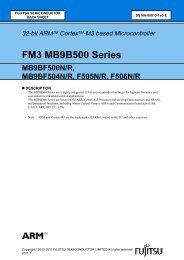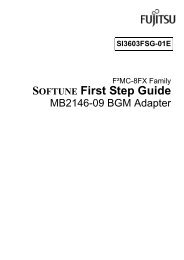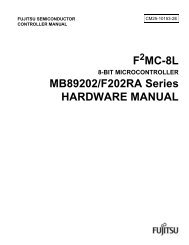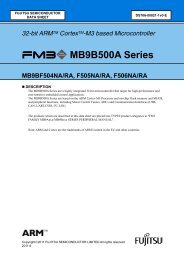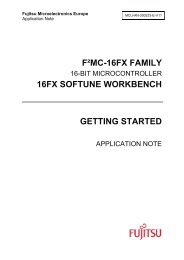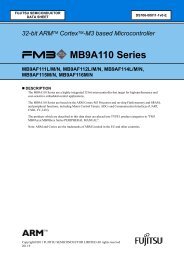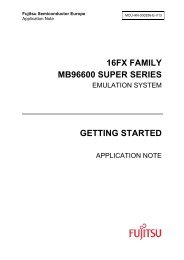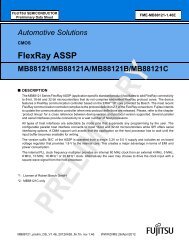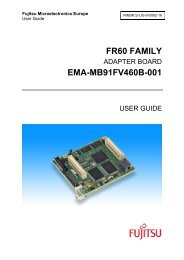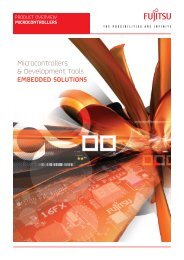FR60 MB91460E Series - Microcontrollers - Fujitsu
FR60 MB91460E Series - Microcontrollers - Fujitsu
FR60 MB91460E Series - Microcontrollers - Fujitsu
Create successful ePaper yourself
Turn your PDF publications into a flip-book with our unique Google optimized e-Paper software.
<strong>MB91460E</strong> <strong>Series</strong><br />
4.4. New feature: Switching back from RC to Main Oscillation<br />
The initial point of this scenario is that the Main clock was missing, the Main clock supervisor has set the MM<br />
flag and switched to RC clock. The CPU already got reset (INIT) from clock supervisor and has detected MM=1<br />
as reset source (See "Check if reset was asserted by the Clock Supervisor" on P. 73). The user is quite sure<br />
that the Main clock returned meanwhile or will return soon and wants to switch back to Main clock.<br />
• The MM flag can be cleared by writing ‘0’ (bit 6 of CSVCR).<br />
• If the Main clock is still missing during the write access, the write operation has no effect, the MM flag keeps<br />
‘1’ value and the clock supervisor continues giving out RC clock.<br />
• If the Main clock is operating during the write access, the MM flag is cleared and the clock is switched back<br />
to Main clock.<br />
• It is possible to poll the MM flag until the Main clock is resumed:<br />
ldi #_csvcr,r1<br />
clear_CSV_loop:<br />
bandh #0b1001,@r1 ;; Clear MM+SM<br />
btsth #0b0110,@r1 ;; Check: Is one of them 1?<br />
bne clear_CSV_loop<br />
4.5. New feature: Switching back from RC to Sub Oscillation<br />
The initial point of this scenario is that the CPU is running on Sub clock and Sub clock was missing. The Sub<br />
clock supervisor has set the SM flag and switched to RC clock (divided by 2). A clock supervisor reset was not<br />
generated because of CSVCR.SRST was ‘0’. Now the CPU is running user software on RC clock. The flag<br />
SM=1 was found by polling. The user is quite sure that the Sub oscillation returned meanwhile or will return<br />
soon and wants to switch back to Sub oscillation.<br />
• The SM flag can be cleared by writing ‘0’ (bit 5 of CSVCR).<br />
• If the Sub clock is still missing during the write access, the write operation has no effect, the SM flag keeps<br />
‘1’ value and the clock supervisor continues giving out RC clock.<br />
• If the Sub clock is operating during the write access, the SM flag is cleared and the clock is switched back to<br />
Sub clock.<br />
• It is possible to poll the SM flag like described in the Main clock example above.<br />
4.6. Sub clock modes<br />
The Main clock supervisor is automatically disabled in Sub clock modes. The enable bit MSVE remains unchanged.<br />
At transition from Sub clock mode to Main clock mode the Main clock supervisor is enabled after the<br />
’oscillation stabilization wait time’ or in case the Main clock is missing before the completion of the ’oscillation<br />
stabilization wait time’, after the ’Main clock timeout’ (TO_MCLK) from the timeout counter. The timeout counter<br />
is clocked with CLKRC.<br />
4.7. Changing the behaviour upon transition to Sub clock mode if the Sub clock has already<br />
stopped in Main clock mode<br />
If the Sub clock has stopped in Main clock mode and this was detected by the Sub clock supervisor, the behaviour<br />
upon transition to Sub clock mode depends on the state of the SRST bit.<br />
• If SRST is set to ’0’ (initial value), reset is not asserted at the transition to Sub clock mode. The transition is<br />
performed using the RC-oscillation clock as Sub clock. In this case it is recommended to check the SM bit<br />
before the transition to Sub clock mode to get the information if Sub clock or CLKRC is used.<br />
• If SRST is set to ’1’, reset is asserted at the transition to Sub clock mode.<br />
The following timing diagrams (Figure 0-11, Figure 0-12, ) illustrate this behaviour.<br />
66 DS705-00002-1v3-E



